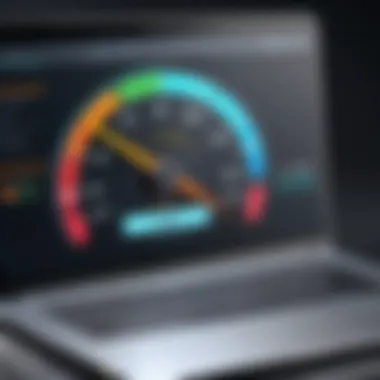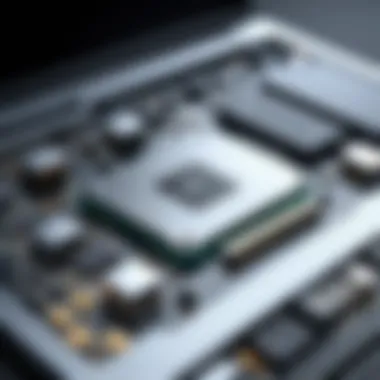Mastering Laptop Performance: Boost Speed & Efficiency


Intro
As laptops become integral to our daily activities, performance concerns often arise, dampening the user experience. A sluggish laptop can hinder productivity, limit multitasking capacity, and frustrate even the most patient individual. This guide addresses the pressing need for improved laptop performance, offering practical solutions to restore speed and efficiency through software optimization, hardware adjustments, and regular maintenance.
In the sections that follow, readers will explore key features of laptop performance enhancements, specifications that matter for upgrades, and actionable strategies for effective system maintenance. Each approach is designed to serve not only casual users but also tech enthusiasts who desire to maximize their device's capabilities. A cohesive understanding of these components will enable users to implement changes that lead to noticeable improvements in their laptops' performance.
Understanding Laptop Performance
Understanding laptop performance is critical for anyone seeking to optimize their computing experience. Performance issues can hinder productivity, lead to frustration, and generally reduce the laptop's utility. Many factors contribute to the overall speed and efficiency of a laptop, making it essential for users to grasp these fundamental aspects. By being informed about performance metrics, users can make better choices regarding upgrades and maintenance, ultimately achieving a smoother and faster use of their device.
The Basics of Laptop Speed
At the core of laptop performance lies speed, which refers to how quickly tasks can be executed. Speed is not merely about clock rates; it incorporates various system characteristics including processing power, memory, and storage solutions. A faster laptop can execute applications swiftly, boot up without lag, and handle multiple tasks without crashing. It effectively translates to an enhanced user experience, allowing for greater efficiency in day-to-day computing tasks.
Key Factors Influencing Performance
Several key factors influence how well a laptop performs. These include processor speed, RAM capacity, and storage type. Each has its unique characteristics that can profoundly impact overall speed and performance.
Processor Speed
Processor speed is a crucial aspect of laptop performance. It is often measured in gigahertz (GHz), indicating how many cycles a processor can execute per second. A higher processor speed typically means faster data processing, leading to improved application performance and quicker execution of tasks. Modern processors often come with multiple cores, enhancing their ability to manage multiple threads or applications simultaneously. This makes a multicore processor a beneficial choice for users who demand performance for multitasking or heavy applications, such as gaming or video editing. The downside, however, can be a higher energy consumption and heat production, which might necessitate better cooling solutions to prevent overheating.
RAM Capacity
RAM capacity is another fundamental factor influencing laptop performance. RAM, or Random Access Memory, serves as short-term memory that stores data for quick access. More RAM allows laptops to run more applications concurrently without slowdowns. For most users, 8GB is a starting point, while power users might require 16GB or more. The main advantage of having ample RAM is improved multitasking efficiency. However, upgrading RAM can be cost-prohibitive, and not all laptops allow easy upgrading, making compatibility an important consideration.
Storage Type
The type of storage in a laptop greatly affects its performance as well. Solid State Drives (SSD) are known for their rapid data access speeds compared to traditional Hard Disk Drives (HDD). An SSD significantly decreases boot times and application load times, providing a noticeable improvement in everyday use. However, SSDs tend to be pricier per gigabyte than HDDs, and users may need to weigh the costs against their storage needs. In this regard, storage choice can be pivotal in determining both performance and affordability, particularly for users with large data storage requirements.
"Understanding the integral components affecting laptop performance leads to informed upgrade and maintenance decisions, empowering users to maximize their computing experience."
For anyone looking to enhance the speed of their laptop, it is essential to evaluate these key performance factors critically. By doing so, users can identify tailored strategies to improve their device's performance, resulting in a more efficient and satisfying computing experience.
Evaluating Your Current Setup
Evaluating your current setup is a crucial step in improving your laptop's performance. Before implementing any modifications or enhancements, understanding your existing environment allows for targeted optimization. This assessment can help you recognize specific weaknesses, enabling you to apply effective solutions. Furthermore, it serves as a benchmark for measuring future improvements.
Checking System Specifications
Checking system specifications involves looking at the key components that define your laptop's abilities. It is essential to know details such as the processor model, amount of RAM, and the type of storage drive. This information lays the foundation for understanding performance capacity. Various tools can help you view these specifications easily, such as the built-in system information tool on Windows or third-party apps like CPU-Z. By identifying your laptop’s specifications, you will gain insights on possible upgrades or optimizations that can be made, ensuring that every enhancement is appropriate and effective.
Identifying Performance Bottlenecks
Understanding performance bottlenecks can reveal what is slowing down your laptop. Several common issues often impact performance.
Slow Boot Times
Slow boot times can significantly hinder productivity. This aspect slows down the time it takes to access your desktop after powering on. A key characteristic of slow boot times is the delay experienced during the application launch process. Many users find this frustrating, making it an important area to address.
One unique feature of slow boot times is the impact of antivirus scans at startup. While necessary for security, these scans can prolong the startup process. Addressing slow boot times may involve reviewing and optimizing startup programs, or upgrading to a solid-state drive for faster access times.
Application Lag
Application lag refers to the delayed response when interacting with software programs. This issue is often depicted in the way applications freeze or take a long time to respond. This characteristic can lead to reduced efficiency and user frustration. In the context of this article, addressing application lag is vital.


A unique feature to consider with application lag is the role of RAM capacity. Insufficient RAM can limit the number of processes your laptop can handle simultaneously. Upgrading RAM or closing unnecessary applications can often alleviate application lag, enhancing the overall use experience.
Overheating Issues
Overheating issues contribute significantly to performance problems in laptops. High temperatures can cause thermal throttling, which reduces processing power to cool down the device. A key characteristic of overheating is the action of fans running excessively to disperse heat. This is crucial for the overall health of your laptop.
Overheating can result from dust accumulation in vents or an underperforming cooling system. Cleaning the vents or replacing thermal paste helps maintain optimal temperatures. Addressing overheating is essential for improving longevity and performance.
Identifying these performance bottlenecks is a foundational step in the journey toward an optimized laptop.
By regularly evaluating your laptop's current setup and addressing these key issues, users can take significant strides toward achieving a faster and more efficient computing experience.
Software Optimization Techniques
Software optimization is a crucial aspect in enhancing laptop performance. This process involves adjusting settings, managing installed programs, and regularly updating software to improve the efficiency and speed of the device. Efficient software management not only reduces lag but also contributes to a smoother user experience. Speeding up your laptop often starts with the applications and systems that run on it. By being proactive about software, users can see notable improvements in performance without the need for immediate hardware upgrades.
Uninstalling Unnecessary Programs
Uninstalling unnecessary programs is one of the first steps towards optimizing laptop performance. Over time, many users accumulate software that they never use. These can take up valuable storage space and consume system resources, leading to sluggish performance. To uninstall these programs, users can go to the control panel or settings menu, review installed applications, and remove those that are not needed. It is important to periodically review these applications to ensure that only what is necessary remains on the system. This simple task can provide immediate improvements in speed and responsiveness.
Managing Startup Applications
Managing startup applications is another effective technique. Many programs automatically launch during boot-up, which can substantially increase boot times. Users can adjust startup settings through the task manager or system settings and disable programs that are not essential at startup. This allows the operating system to allocate more resources to vital tasks, leading to a quicker startup and better overall performance. Users should decide wisely which applications need to run at startup and keep only the most critical ones enabled.
Regularly Updating Software
Regular software updates are critical for maintaining laptop performance. An up-to-date software system benefits from improved security, enhanced features, and often better speed, resulting from bug fixes and performance patches. Keeping software current is more efficient than troubleshooting problems later, as updates can prevent many issues before they arise.
Operating System Updates
Operating system updates address various facets of performance optimization. These updates often include security enhancements, stability improvements, and feature upgrades. A key characteristic of operating system updates is their ability to provide essential fixes that improve overall functionality. Regular updates can help boost system performance by optimizing how the operating system interacts with hardware components. However, users should also be aware that sometimes updates can introduce new issues or require adjustments, which is a disadvantage to consider.
Application Updates
Similar to operating system updates, application updates are essential for keeping installed programs functioning at their best. These updates often include new features and fixes for performance-related issues. A significant aspect of application updates is their role in enhancing security, as many applications may be targets for malware or other threats. Keeping applications up to date ensures users benefit from the latest improvements and maintains the efficiency of programs running on the laptop. However, there are times when users may experience compatibility issues post-update, which can be considered a downside of frequent updates.
Using Performance-Enhancing Software
Using performance-enhancing software can offer another layer of optimization for laptops. Such software focuses on improving performance by identifying unnecessary files, managing system processes, and optimizing disk usage. Tools in this category can automate various maintenance tasks, making it easier for users to maintain an efficient system.
Disk Cleanup Tools
Disk cleanup tools are designed to free up storage space by removing temporary files, system cache, and other unnecessary data. The unique feature of these tools is their ability to streamline hard drive performance without requiring manual deletion of files. This makes them a popular choice for users looking to improve speed easily. It is important to note, however, that regular use of these tools can lead to better performance, but over-dependence may mask underlying issues that need attention.
Antivirus and Malware Scanners
Antivirus and malware scanners play a vital role in maintaining laptop performance by ensuring the system remains free of malicious software. These tools can detect threats that may not only compromise data security but also slow down system operations. Their main strength lies in real-time protection and regular scans that help maintain optimal performance. However, overly aggressive scanners can occasionally interfere with normal operations or system speed, which is a consideration for users choosing the right software.
Hardware Upgrades for Better Performance
When discussing ways to enhance laptop performance, hardware upgrades stand out as a crucial strategy. Unlike software optimizations, which can provide incremental improvements, hardware upgrades can significantly boost your laptop's capabilities. For many users, upgrading hardware offers the fastest route to resolving persistent issues that affect speed and responsiveness. This section explores several essential upgrades that can lead to noticeable enhancements in your laptop’s performance.
Upgrading RAM
Benefits of Additional Memory
Upgrading your laptop’s RAM can result in a substantial improvement in multitasking capabilities. More memory allows for smoother operation when running multiple applications or handling large files. As programs demand more resources over time, an increase in RAM can alleviate slowdowns. Users often notice that their machines boot faster and load applications more quickly after a RAM upgrade. This enhancement is popular because it directly addresses common performance issues without requiring extensive technical skills.


Compatibility Considerations
Before attempting a RAM upgrade, checking compatibility is vital. Laptops have specific memory types and maximum capacities that their motherboards can support. Knowing the right type of RAM, such as DDR4 or DDR3, is essential. Additionally, understanding whether your laptop allows for dual-channel configurations can lead to improved performance. Not all laptops easily accommodate additional memory, so it's crucial to verify specifications beforehand to avoid investment in incompatible parts.
Switching to Solid State Drives (SSD)
SSD vs. HDD
Switching from a traditional Hard Disk Drive (HDD) to a Solid State Drive (SSD) can dramatically enhance loading times. SSDs utilize flash memory, granting much faster data access speeds compared to HDDs, which rely on moving parts. The reduced latency associated with SSDs can improve boot times and application launches, making them an advantageous choice for users seeking instant responsiveness. Migration from HDD to SSD is increasingly seen as a smart investment for noticeable performance advancement.
Replacing or Cleaning the Cooling System
Importance of Proper Cooling
Effective cooling is essential for maintaining optimal performance. As laptops operate, especially under significant workload, they generate heat. Excessive heat can lead to throttling, where the CPU or GPU reduces performance to cool down. Regularly maintaining the cooling system prevents overheating, ensuring that components run at their maximum potential. A well-cooled laptop maintains higher performance levels, allowing for extended periods of intense activity without degradation.
Steps for Cleaning the Fan
Cleaning the laptop fan is a straightforward yet impactful maintenance task. Begin by powering off and unplugging the laptop to mitigate risks. Use a can of compressed air to blow dust from the vents and fan, carefully avoiding the use of liquids. Recurrently cleaning the fan can help maintain airflow, thus supporting better cooling efficiency. Users may also consider periodically checking for dust build-up inside the chassis.
Keeping our laptops clean and well-cooled is often overlooked but is vital for sustained performance. Regular checks can reveal surprising improvements in speed and responsivness.
By addressing these hardware components, users can significantly improve their laptop’s speed and overall performance. Each upgrade contributes to a more efficient and responsive machine, crucial for both work and play.
System Maintenance Practices
Maintaining your laptop effectively plays a crucial role in ensuring optimum performance. System maintenance practices can help keep the laptop running smoothly, extend its lifespan, and prevent problems before they start. Regular maintenance can lead to noticeable improvements in speed and efficiency. Beyond just addressing immediate performance issues, these practices help in fostering a habit of vigilance and care towards the device.
Regular Disk Defragmentation
Disk defragmentation is an essential process, particularly for laptops using traditional Hard Disk Drives (HDDs). Over time, as files get added and deleted from storage, fragmentation occurs. This means that files are scattered across different sectors of the disk, leading to longer access times. Regularly defragmenting the disk rearranges the data, placing files closer together. This can improve the read times significantly.
To perform disk defragmentation on a Windows system:
- Open the 'Start' menu and type "Defragment and Optimize Drives".
- Select the disk you wish to optimize.
- Click on "Optimize".
Conducting this process periodically can lead to enhanced performance in file opening and loading applications.
Data Backup Strategies
Establishing effective data backup strategies is vital for protecting your laptop's information. Regular backups ensure that data loss does not occur due to unexpected issues such as system crashes or hardware failures. Implementing a backup routine can range from using physical external drives to cloud-based storage solutions like Google Drive or Dropbox.
Consider setting up automatic backups to streamline the process. Here are a few reliable methods for data backup:
- External Hard Drives: Create periodic backups by connecting an external hard drive.
- Cloud Services: Utilize services like Google Drive or Microsoft OneDrive for remote storage.
- Built-in Backup Tools: Use software tools available in your operating system like Windows Backup or Time Machine on macOS.
Using a combination of these strategies allows for a robust backup system, making sure your important files are safe at all times.
Tracking System Performance with Monitoring Tools
Monitoring tools are critical for understanding how your laptop operates under various conditions. Using performance monitoring tools can pinpoint issues that may not be obvious through casual use. These tools can track CPU usage, memory consumption, and disk activity. This real-time data helps identify bottlenecks that can be resolved for better efficiency.
Some effective tools include:
- Task Manager (Windows) or Activity Monitor (macOS): These built-in tools provide insights on resource usage and application performance.
- HWMonitor: A third-party application that shows real-time hardware sensor data.
- CrystalDiskInfo: Useful for monitoring the health of your hard drive.
Utilizing these tools not only assists in troubleshooting existing issues but also helps in planning ahead for future upgrades or replacements. Regular monitoring establishes a clear understanding of your laptop’s performance dynamics.


Advanced Solutions for Persistent Issues
When laptops exhibit significant performance issues that standard remedies fail to resolve, exploring advanced solutions becomes essential. This section delves into two key areas: reinstalling the operating system and adjusting BIOS/UEFI settings. Mastering these advanced techniques can lead to a noticeable uptick in system performance, ensuring that users can effectively address persistent problems that impede their computing experience.
Reinstalling the Operating System
Benefits and Risks
Reinstalling the operating system can be a drastic yet often necessary measure. This process allows for the removal of any corrupted system files or problematic software that may be causing sluggish performance.
The key benefit of this method is a fresh start for your laptop. It can eradicate years of accumulated software clutter, malware, and system bugs. Consequently, users often experience improved speed and responsiveness following a clean installation.
However, the risks of this approach cannot be ignored. A fresh install entails backing up data and applications, which may result in loss if not executed properly. It also requires time and a certain level of technical know-how, making it less accessible for all users.
In summary, reinstalling the operating system presents a significant opportunity to restore performance but involves careful planning to mitigate potential downsides.
Steps to Reinstall
Reinstalling an operating system requires a structured approach. Start by backing up all critical data to avoid unwanted loss. Utilize external drives or cloud services for effective data management.
Next, ensure you have the installation media ready. This can be a USB flash drive or a DVD containing the operating system. Follow these general steps:
- Access the BIOS settings
Restart the laptop and enter the BIOS setup by pressing the appropriate key (often F2, F12, or Delete). - Change boot order
Set your installation media as the primary boot device. - Install the operating system
Follow on-screen prompts to complete the installation process. - Restore your data
After installation, transfer backed-up files back onto the laptop.
Following these steps eases the process while ensuring users have a cleaner, optimized system.
Exploring BIOS/UEFI Settings
Optimizing Boot Order
Optimizing the boot order in your laptop's BIOS or UEFI settings can influence the overall performance. This aspect is particularly relevant for those running multiple drives or operating systems. By setting the primary boot device to your solid-state drive (SSD), you can significantly reduce boot times.
This adjustment highlights the importance of speed in startup processes. By prioritizing the quickest drive, users can ensure their system reaches the desktop without delay. This not only enhances the user experience but also suggests a leaner approach to system efficiency.
Although modifying BIOS settings might seem daunting, the outcome; faster boot times can justify the initial hesitation.
Enabling Hardware Features
Enabling hardware features in BIOS/UEFI can further enhance performance. This includes features like virtualization support or settings that support new memory standards. Doing so can unlock additional capabilities of your laptop, such as better processing power for intensive applications.
The main characteristic of enabling hardware features includes potential improvements in performance due to more efficient resource usage. Some laptops may not fully utilize their hardware without these settings adjusted.
However, users should tread carefully. Incorrect settings can lead to instability. Thus, it is advisable to document original settings before making changes, allowing for easy rollback if needed.
Ultimately, adjusting BIOS/UEFI settings is a worthwhile endeavor for tech-savvy users looking to squeeze out every ounce of performance from their devices.
Culmination
Understanding how to enhance laptop performance is crucial for users aiming to optimize their computing experience. This article presents various strategies that cater to the diverse needs of both casual users and technology enthusiasts. The focus is on actionable solutions, ranging from software optimizations to hardware upgrades. By implementing these techniques, users can experience significant improvements in speed and efficiency.
Summary of Key Strategies
The core strategies discussed in this article include:
- Software Optimization: Uninstalling unnecessary programs, managing startup applications, and keeping software updated are essential steps.
- Hardware Upgrades: Adding RAM, switching to an SSD, and maintaining the cooling system can greatly enhance performance.
- System Maintenance: Regular disk defragmentation and data backup strategies are valuable in prolonging system life.
- Advanced Solutions: Reinstalling the operating system and tweaking BIOS settings help manage persistent issues.
Each point plays a vital role in ensuring laptops operate at their best, thereby improving user satisfaction and productivity.
Final Thoughts on Performance Optimization
"A well-maintained laptop is not just faster; it's also more reliable and built for the long haul."
Adopting a measured approach towards performance optimization helps in maximizing the potential of your device, ensuring it remains useful for years to come.



